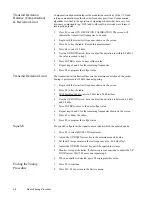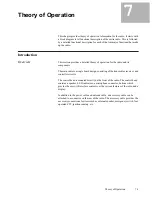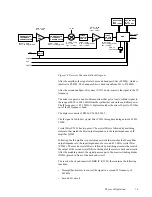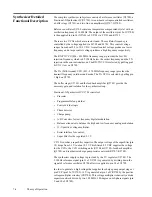
7-14
Theory of Operation
Controller Audio &
Signaling Circuits
General
Audio Signalling Filter IC
(ASFIC)
The ASFIC (U0201) used in the controller has four functions;
•
RX/TX audio shaping, i.e. filtering, amplification, attenuation
•
RX/TX signalling, PL/DPL/HST/MDC/MPT
•
Squelch detection
•
Microprocessor clock signal generation (see Microprocessor Clock
Synthesizer Description Block).
The ASFIC is programmable through the SPI BUS (U0201-E3/F1/F2), normally
receiving 21 bytes. This programming sets up various paths within the ASFIC to
route audio and/or signalling signals through the appropriate filtering, gain and
attenuator blocks. The ASFIC also has 6 General Control Bits GCB0-5 which are
CMOS level outputs and used for AUDIO PA ENABLE (GCB0) to switch the
audio PA on and off, EXTERNAL ALARM (GCB1) and B+ CONTROL (GCB2)
to switch the voltage regulators (and the radio) on and off. GCB3 controls output
GPI/O (accessory connector J0400-12), HIGH LOW BAND (GCB4) can be used
to switch between band splits and GCB5 is available on the option board
connector J0102-5.
Audio Ground
VAG is the dc bias used as an audio ground for the op-amps that are external to
the Audio Signalling Filter IC (ASFIC). U0251 forms this bias by dividing 9.3V
with resistors R0251, R0252, and buffering the 4.65V result with a voltage
follower. VAG emerges at pin 1 of U0251. C0235 is a bypass capacitor for VAG.
The ASFIC generates its own 2.5V bias for its internal circuitry. C0221 is the
bypass for the ASFIC’s audio ground dc bias.
Note:
While there are ASFIC VAG, and BOARD VAG (U0201-1),
each of these are separated. They are not connected together.
Transmit Audio Circuits
Refer to the following sections.
Mic Input Path
The radio supports two distinct microphone paths known as internal and external
mic and an auxiliary path (FLAT TX AUDIO). The microphones used for the
radio require a DC biasing voltage provided by a resistive network.
These two microphone audio input paths enter the ASFIC at U0201-A7 (external
mic) and U0201-B8 (internal mic). Following the internal mic path; the
microphone is plugged into the radio control head and is connected to the
controller board via J101-16.
From here the signal is routed to R0206. R0204 and R0205 provide the 9.3VDC
bias and R0206 provides input protection for the CMOS amplifier input. R0205
and C0209 provide a 1kohm AC path to ground that sets the input impedance for
the microphone and determines the gain based on the emitter resistor in the
microphone’s amplifier circuit.






























